Degradation Trend Prediction of Pumped Storage Unit Based on MIC-LGBM and VMD-GRU Combined Model
Abstract
:1. Introduction
- (a)
- Considering that the relationships between the working condition parameters and the state data are not linear, MIC is utilized to screen the relevant working parameters. The interference of irrelevant working parameters is reduced, and the performance of the healthy model is improved.
- (b)
- Inspired by the superiority of LGBM, the healthy model is constructed and not only achieves a high-precision fitting result but also consumes fewer computational resources as it has a strongly competitive training speed.
- (c)
- To address the challenges caused by the complexity of PDI sequences, the VMD-GRU prediction model is designed for reliable prediction. The complex degradation trend is decomposed into a series of simple sequences by VMD, which can be more adequately learned by GRU. An outstanding prediction result is obtained compared with other popular prediction models.
2. Theoretical Background
2.1. Maximal Information Coefficient
2.2. Light Gradient Boosting Machine
- (a)
- Gradient-based one-side sampling (GOSS). Data with large gradients contribute more to the model and require more attention during training, while those with small gradients are already sufficiently learned by the model. GOSS is applied to make the model focus more on data with large gradients, while avoiding large variations in the distribution of training data. The process of GOSS is described as follows. Firstly, data are sorted according to the gradient by decreasing order. Afterwards, the top a% of data are retained, and b% of the remaining data is randomly selected. Finally, the information gain is calculated and the gradient of the selected b% data is multiplied by .
- (b)
- Exclusive feature bundling (EFB). EFB is effective when data are high-dimensional. It bundles mutually exclusive features to reduce the number of features, thus increasing the training speed without reducing the training accuracy.
- (c)
- Histogram-based algorithm. The continuous features are discretized into bins, which are utilized to generate the histogram during training, and the optimal segmentation point is found by traversing the discrete value in the histogram, as shown in Figure 1. This approach reduces the memory consumption.
- (d)
- Leaf-wise growth strategy. The level-wise growth strategy splits plenty of redundant leaves with low gain, which excessively consumes computational resources [45], while the leaf-wise growth strategy achieves higher precision by splitting the leaf with the greatest gain. The comparison of the above growth strategies is shown in Figure 2.
2.3. Variational Mode Decomposition
2.4. Gated Recurrent Unit
3. The DTP Model Based on MIC-LGBM and VMD-GRU
3.1. Working Parameters Selection by MIC
- (1)
- Calculate the correlation between and by the MIC in Section 2.1.
- (2)
- Obtain the selection threshold as follows:
- (3)
- The working parameter is selected as input of the healthy model if .
3.2. Healthy Model Construction and PDI Generation
3.2.1. Part A: Healthy Model Construction
- (1)
- The period when the PSU is running well is selected as the benchmark state. The selected working parameters under benchmark state are used as the input of the LGBM healthy model, and the corresponding healthy status data are adopted as the output of the LGBM healthy model. Thus, the nonlinear mapping relationship is established as follows:
- (2)
- The trial-and-error method is utilized to determine the optimal parameters of LGBM.
3.2.2. Part B: PDI Generation
3.3. Degradation Trend Prediction with VMD-GRU
- (a)
- RMSE:
- (b)
- MAE:
- (c)
- :where and denote the actual PDI and predicted PDI, respectively. is the length of the actual PDI, and is the average of .
4. Case Study
4.1. Data Source
4.2. Working Parameter Selection Based on MIC
4.3. Healthy Model Establishment and PDI Construction
4.3.1. Comparative Healthy Models and Parameter Settings
4.3.2. Performance Analysis and Discussion of Healthy Models
4.3.3. PDI Construction with LGBM Healthy Model
4.4. Degradation Trend Prediction of PSU
4.4.1. Comparative Prediction Models and Parameter Settings
4.4.2. Performance Analysis and Discussion of Prediction Models
- (1)
- Challenges brought by the complex PDI sequence
- (2)
- Comparison of VMD-based models with other models
- (3)
- Comparison of GRU-based models with other models
5. Conclusions
Author Contributions
Funding
Data Availability Statement
Conflicts of Interest
References
- Wu, G.; Shao, X.; Jiang, H.; Chen, S.; Zhou, Y.; Xu, H. Control strategy of the pumped storage unit to deal with the fluctuation of wind and photovoltaic power in microgrid. Energies 2020, 13, 415. [Google Scholar] [CrossRef] [Green Version]
- Hydropower Status Report 2021. Available online: https://www.hydropower.org/status-report (accessed on 3 January 2022).
- Lai, X.; Li, C.; Zhou, J.; Zhang, N. Multi-objective optimization of the closure law of guide vanes for pumped storage units. Renew. Energy 2019, 139, 302–312. [Google Scholar] [CrossRef]
- Zhao, Z.; Yang, J.; Yang, W.; Hu, J.; Chen, M. A coordinated optimization framework for flexible operation of pumped storage hydropower system: Nonlinear modeling, strategy optimization and decision making. Energy Convers. Manag. 2019, 194, 75–93. [Google Scholar] [CrossRef]
- Zheng, Y.; Chen, Q.; Yan, D.; Liu, W. A two-stage numerical simulation framework for pumped-storage energy system. Energy Convers. Manag. 2020, 210, 112676. [Google Scholar] [CrossRef]
- Lei, Y.; Li, N.; Guo, L.; Li, N.; Yan, T.; Lin, J. Machinery health prognostics: A systematic review from data acquisition to RUL prediction. Mech. Syst. Signal Process. 2018, 104, 799–834. [Google Scholar] [CrossRef]
- Shan, Y.; Liu, J.; Xu, Y.; Zhou, J. A combined multi-objective optimization model for degradation trend prediction of pumped storage unit. Measurement 2021, 169, 108373. [Google Scholar] [CrossRef]
- Hu, X.; Li, C.; Tang, G. In A hybrid model for predicting the degradation trend of hydropower units based on deep learning. In Proceedings of the 2019 Prognostics and System Health Management Conference (PHM-Qingdao), Qingdao, China, 25–27 October 2019; pp. 1–5. [Google Scholar]
- Zhou, J.; Shan, Y.; Liu, J.; Xu, Y.; Zheng, Y. Degradation tendency prediction for pumped storage unit based on integrated degradation index construction and hybrid CNN-LSTM model. Sensors 2020, 20, 4277. [Google Scholar] [CrossRef]
- An, X.; Pan, L. Characteristic parameter degradation prediction of hydropower unit based on radial basis function surface and empirical mode decomposition. J. Vib. Control. 2015, 21, 2200–2211. [Google Scholar] [CrossRef]
- An, X.; Yang, L.; Pan, L. Nonlinear prediction of condition parameter degradation trend for hydropower unit based on radial basis function interpolation and wavelet transform. Proc. Inst. Mech. Eng. Part C J. Mech. Eng. Sci. 2015, 229, 3515–3525. [Google Scholar] [CrossRef]
- An, X.; Pan, L.; Yang, L. Condition parameter degradation assessment and prediction for hydropower units using Shepard surface and ITD. Trans. Inst. Meas. Control. 2014, 36, 1074–1082. [Google Scholar] [CrossRef]
- Sagi, O.; Rokach, L. Ensemble learning: A survey. WIREs Data Mining Knowl Discov. 2018, 8, e1249. [Google Scholar] [CrossRef]
- Cai, R.; Xie, S.; Wang, B.; Yang, R.; Xu, D.; He, Y. Wind speed forecasting based on extreme gradient boosting. IEEE Access 2020, 8, 175063–175069. [Google Scholar] [CrossRef]
- Zheng, H.; Wu, Y. A XGBoost model with weather similarity analysis and feature engineering for short-term wind power forecasting. Appl. Sci. 2019, 9, 3019. [Google Scholar] [CrossRef] [Green Version]
- Tao, T.; Liu, Y.; Qiao, Y.; Gao, L.; Lu, J.; Zhang, C.; Wang, Y. Wind turbine blade icing diagnosis using hybrid features and Stacked-XGBoost algorithm. Renew. Energy 2021, 180, 1004–1013. [Google Scholar] [CrossRef]
- Trizoglou, P.; Liu, X.; Lin, Z. Fault detection by an ensemble framework of extreme gradient boosting (XGBoost) in the operation of offshore wind turbines. Renew. Energy 2021, 179, 945–962. [Google Scholar] [CrossRef]
- Alsaleh, A.; Binsaeedan, W. The influence of salp swarm algorithm-based feature selection on network anomaly intrusion detection. IEEE Access 2021, 9, 112466–112477. [Google Scholar] [CrossRef]
- Truong, D.; Tran, D.; Nguyen, L.; Mac, H.; Tran, H.A.; Bui, T. Detecting web attacks using stacked denoising autoencoder and ensemble learning methods. In Proceedings of the Tenth International Symposium on Information and Communication Technology, Association for Computing Machinery, Hanoi, Vietnam, 4–6 December 2019; pp. 267–272. [Google Scholar]
- Ke, G.; Meng, Q.; Finley, T.; Wang, T.; Chen, W.; Ma, W.; Ye, Q.; Liu, T.-Y. LightGBM: A highly efficient gradient boosting decision tree. In Proceedings of the 31st International Conference on Neural Information Processing Systems, Curran Associates Inc., Long Beach, CA, USA, 4–6 December 2017; pp. 3149–3157. [Google Scholar]
- Cerrada, M.; Sánchez, R.-V.; Li, C.; Pacheco, F.; Cabrera, D.; Valente de Oliveira, J.; Vásquez, R.E. A review on data-driven fault severity assessment in rolling bearings. Mech. Syst. Signal Process. 2018, 99, 169–196. [Google Scholar] [CrossRef]
- Reshef David, N.; Reshef Yakir, A.; Finucane Hilary, K.; Grossman Sharon, R.; McVean, G.; Turnbaugh Peter, J.; Lander Eric, S.; Mitzenmacher, M.; Sabeti Pardis, C. Detecting novel Associations in large data sets. Science 2011, 334, 1518–1524. [Google Scholar] [CrossRef] [Green Version]
- Jiang, Y.; Li, C.; Yang, Z.; Zhao, Y.; Wang, X. Remaining useful life estimation combining two-step maximal information coefficient and temporal convolutional network with attention mechanism. IEEE Access 2021, 9, 16323–16336. [Google Scholar] [CrossRef]
- Ji, H.; Huang, S.; Wu, Y.; Hui, Z.; Lv, X. In A New attribute selection method based on maximal information coefficient and automatic clustering. In Proceedings of the 2017 International Conference on Dependable Systems and Their Applications (DSA), Beijing, China, 31 October–2 November 2017; pp. 22–28. [Google Scholar]
- Zhao, L.; Zhang, Y.; Li, J. Research on constructing a degradation index and predicting the remaining useful life for rolling element bearings of complex equipment. J. Mech. Sci. Technol. 2021, 35, 4313–4327. [Google Scholar] [CrossRef]
- Liu, F.; Li, L.; Liu, Y.; Cao, Z.; Yang, H.; Lu, S. HKF-SVR optimized by Krill Herd algorithm for coaxial bearings performance degradation prediction. Sensors 2020, 20, 660. [Google Scholar] [CrossRef] [Green Version]
- Liu, Z.; Guo, Y. In A neural network approach for prediction of bearing performance degradation tendency. In Proceedings of the 2017 9th International Conference on Modelling, Identification and Control (ICMIC), Kunming, China, 10–12 July 2017; pp. 204–208. [Google Scholar]
- Bao, H.; Yan, Z.; Ji, S.; Wang, J.; Jia, S.; Zhang, G.; Han, B. An enhanced sparse filtering method for transfer fault diagnosis using maximum classifier discrepancy. Meas. Sci. Technol. 2021, 32, 085105. [Google Scholar] [CrossRef]
- Park, K.; Choi, Y.; Choi, W.J.; Ryu, H.; Kim, H. LSTM-based battery remaining useful life prediction with multi-channel charging profiles. IEEE Access 2020, 8, 20786–20798. [Google Scholar] [CrossRef]
- Xia, J.; Feng, Y.; Lu, C.; Fei, C.; Xue, X. LSTM-based multi-layer self-attention method for remaining useful life estimation of mechanical systems. Eng. Fail. Anal. 2021, 125, 105385. [Google Scholar] [CrossRef]
- Wu, S.; Jiang, Y.; Luo, H.; Yin, S. Remaining useful life prediction for ion etching machine cooling system using deep recurrent neural network-based approaches. Control Eng. Pract. 2021, 109, 104748. [Google Scholar] [CrossRef]
- Cho, K.; Merrienboer, B.V.; Gulcehre, C.; Ba Hdanau, D.; Bougares, F.; Schwenk, H.; Bengio, Y.J.C.S. Learning phrase representations using RNN encoder-decoder for statistical machine translation. In Proceedings of the 2014 Conference on Empirical Methods in Natural Language Processing (EMNLP), Doha, Qatar, 25–29 October 2019; pp. 1724–1734. [Google Scholar]
- Chen, J.; Jing, H.; Chang, Y.; Liu, Q. Gated recurrent unit based recurrent neural network for remaining useful life prediction of nonlinear deterioration process. Reliab. Eng. Syst. Saf. 2019, 185, 372–382. [Google Scholar] [CrossRef]
- Du, B.; He, Y.; An, B.; Zhang, C. Remaining useful performance estimation for complex analog circuit based on maximal information coefficient and bidirectional gate recurrent unit. IEEE Access 2020, 8, 102449–102466. [Google Scholar] [CrossRef]
- Lu, Y.-W.; Hsu, C.-Y.; Huang, K.-C. An autoencoder gated recurrent unit for remaining useful life prediction. Processes 2020, 8, 1155. [Google Scholar] [CrossRef]
- Huang, N.E.; Shen, Z.; Long, S.R.; Wu, M.C.; Shih, H.H.; Zheng, Q.; Yen, N.C.; Tung, C.C.; Liu, H.H.J.P.M.P.; Sciences, E. The empirical mode decomposition and the Hilbert spectrum for nonlinear and non-stationary time series analysis. Proc. R. Soc. Lond. A 1998, 454, 903–995. [Google Scholar] [CrossRef]
- Dragomiretskiy, K.; Zosso, D. Variational mode decomposition. IEEE Trans. Signal Process. 2014, 62, 531–544. [Google Scholar] [CrossRef]
- He, X.; Luo, J.; Zuo, G.; Xie, J. Daily runoff Forecasting using a hybrid model based on variational mode decomposition and deep neural networks. Water Resour. Manag. 2019, 33, 1571–1590. [Google Scholar] [CrossRef]
- Xiao, F.; Yang, D.; Guo, X.; Wang, Y. VMD-based denoising methods for surface electromyography signals. J. Neural Eng. 2019, 16, 056017. [Google Scholar] [CrossRef] [PubMed]
- He, X.; Luo, J.; Li, P.; Zuo, G.; Xie, J. A hybrid model based on variational mode decomposition and gradient boosting regression tree for monthly runoff forecasting. Water Resour. Manag. 2020, 34, 865–884. [Google Scholar] [CrossRef]
- Ali, M.; Khan, A.; Rehman, N.U. Hybrid multiscale wind speed forecasting based on variational mode decomposition. Int. Trans. Electr. Energy Syst. 2018, 28, e2466. [Google Scholar] [CrossRef]
- Liang, T.; Zhang, Q.; Liu, X.; Lou, C.; Liu, X.; Wang, H. Time-frequency maximal information coefficient method and its application to functional corticomuscular coupling. IEEE Trans. Neural Syst. Rehabil. Eng. 2020, 28, 2515–2524. [Google Scholar] [CrossRef] [PubMed]
- Chen, T.; Guestrin, C. In XGBoost: A scalable tree boosting system. In Proceedings of the 22nd ACM SIGKDD International Conference, Association for Computing Machinery, San Francisco, CA, USA, 13–17 August 2016; pp. 785–794. [Google Scholar]
- Wang, Y.; Wang, T. Application of improved lightGBM model in blood glucose prediction. Appl. Sci. 2020, 10, 3227. [Google Scholar] [CrossRef]
- Zhang, Y.; Zhu, C.; Wang, Q. LightGBM-based model for metro passenger volume forecasting. IET Intell. Transp. Syst. 2021, 14, 1815–1823. [Google Scholar] [CrossRef]
- Bertsekas, D.P. Constrained Optimization and Lagrange Multiplier Methods. Constrained Optimization and Lagrange Multiplier Methods; Academic Press: Cambridge, MA, USA, 1982. [Google Scholar]
- Liu, Y.; Yang, C.; Huang, K.; Gui, W. Non-ferrous metals price forecasting based on variational mode decomposition and LSTM network. Knowl. Based Syst. 2020, 188, 105006. [Google Scholar] [CrossRef]
- Wang, Y.; Zou, R.; Liu, F.; Zhang, L.; Liu, Q. A review of wind speed and wind power forecasting with deep neural networks. Appl. Energy 2021, 304, 117766. [Google Scholar] [CrossRef]
- Li, C.; Tang, G.; Xue, X.; Saeed, A.; Hu, X. Short-Term Wind Speed Interval Prediction Based on Ensemble GRU Model. IEEE Trans. Sustain. Energy 2020, 11, 1370–1380. [Google Scholar]
- Yu, J.; Jang, J.; Yoo, J.; Park, J.H.; Kim, S. A fault isolation method via classification and regression tree-based variable ranking for drum-type steam boiler in thermal power plant. Energies 2018, 11, 1142. [Google Scholar] [CrossRef] [Green Version]
- Lei, Y.; Lin, J.; He, Z.; Zuo, M.J. A review on empirical mode decomposition in fault diagnosis of rotating machinery. Mech. Syst. Signal Process. 2013, 35, 108–126. [Google Scholar] [CrossRef]
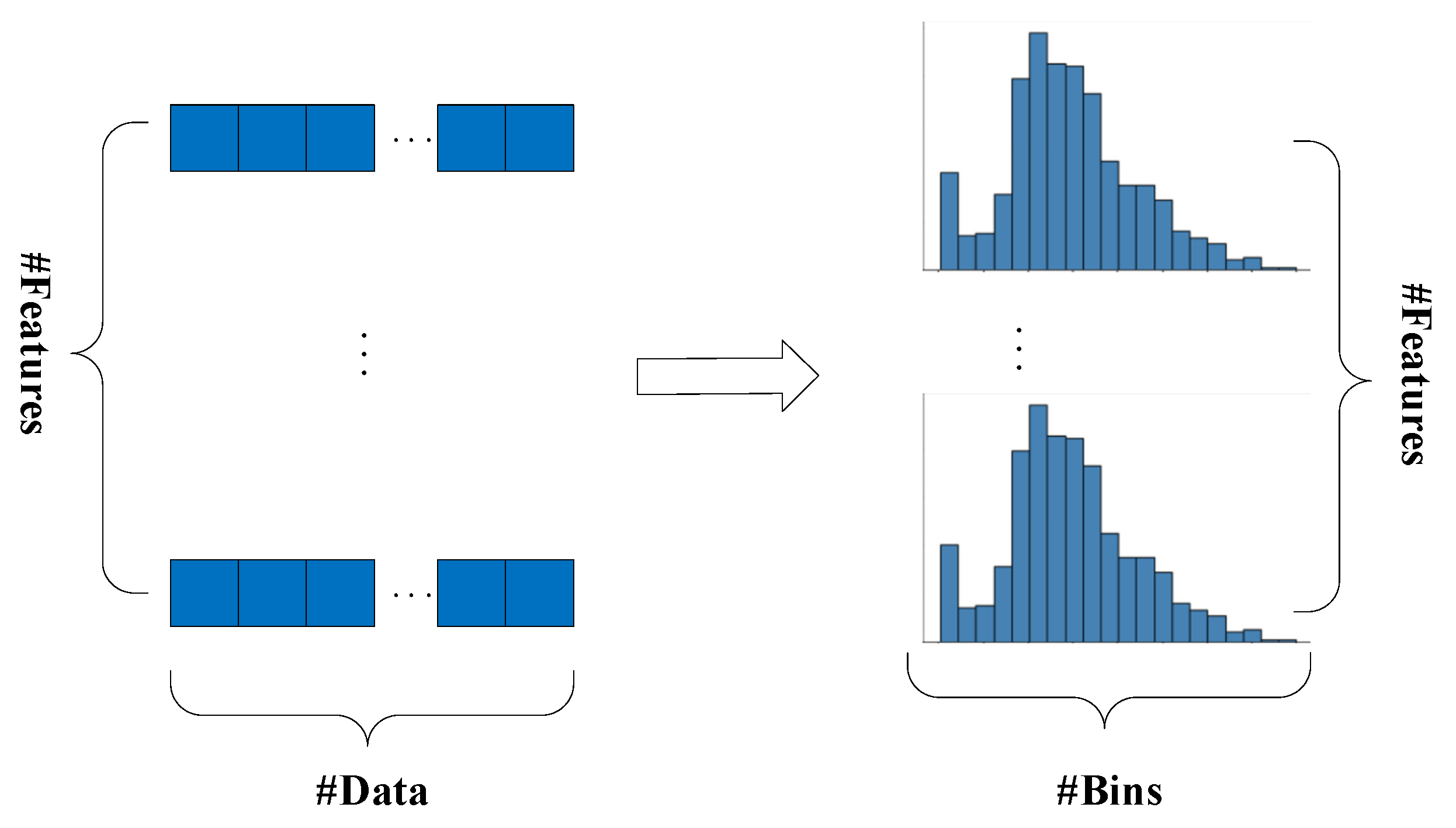

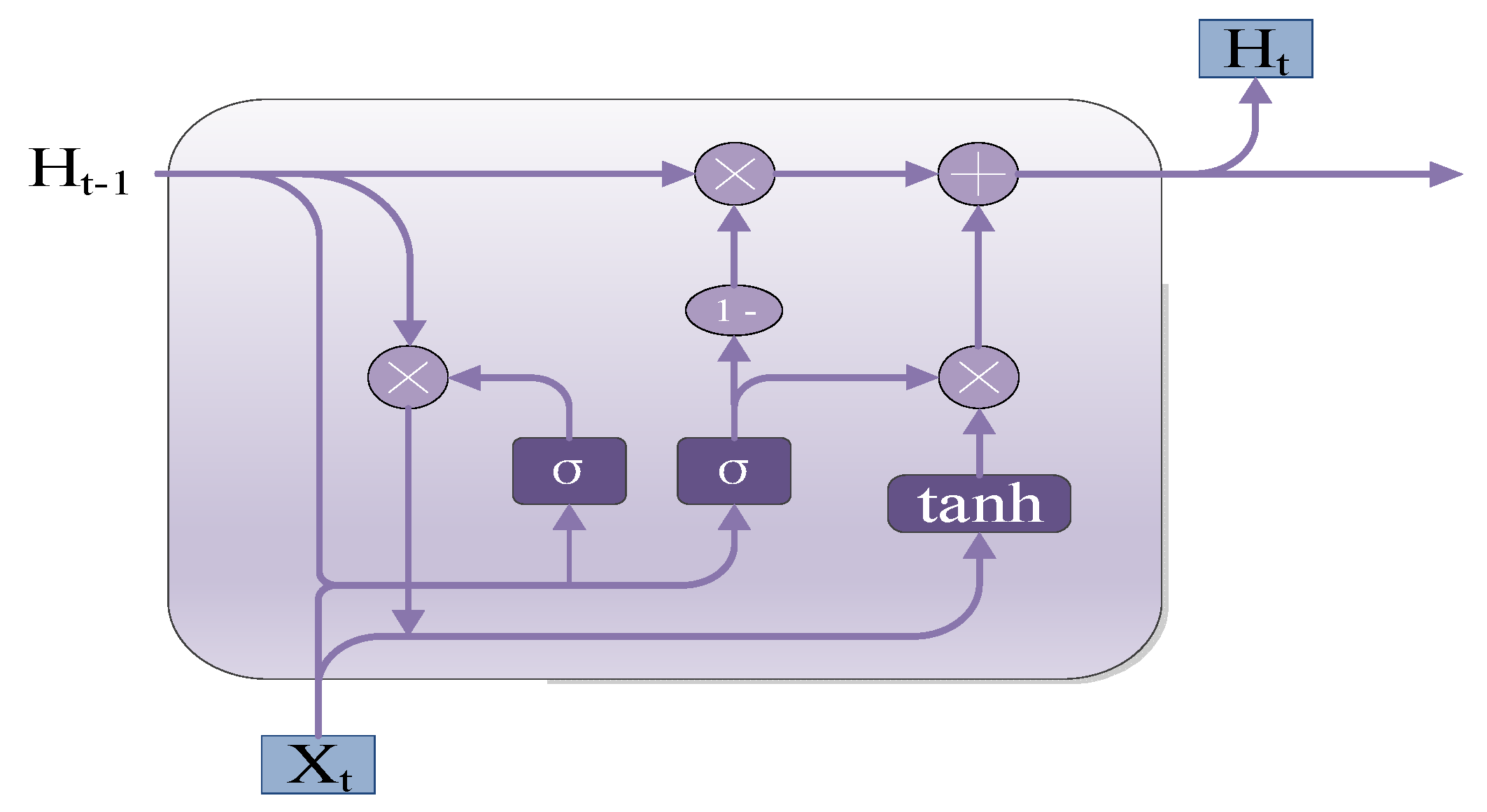
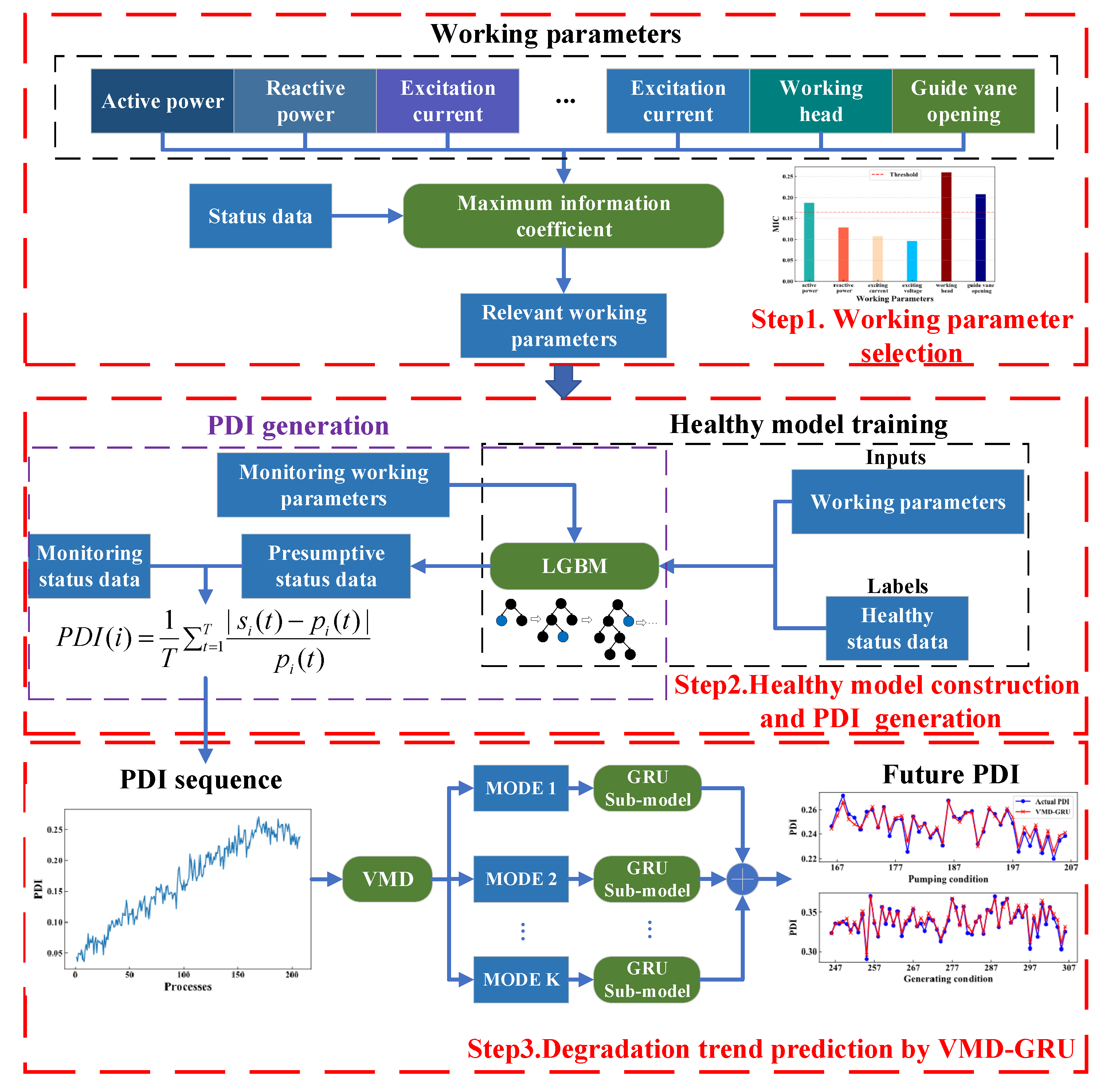
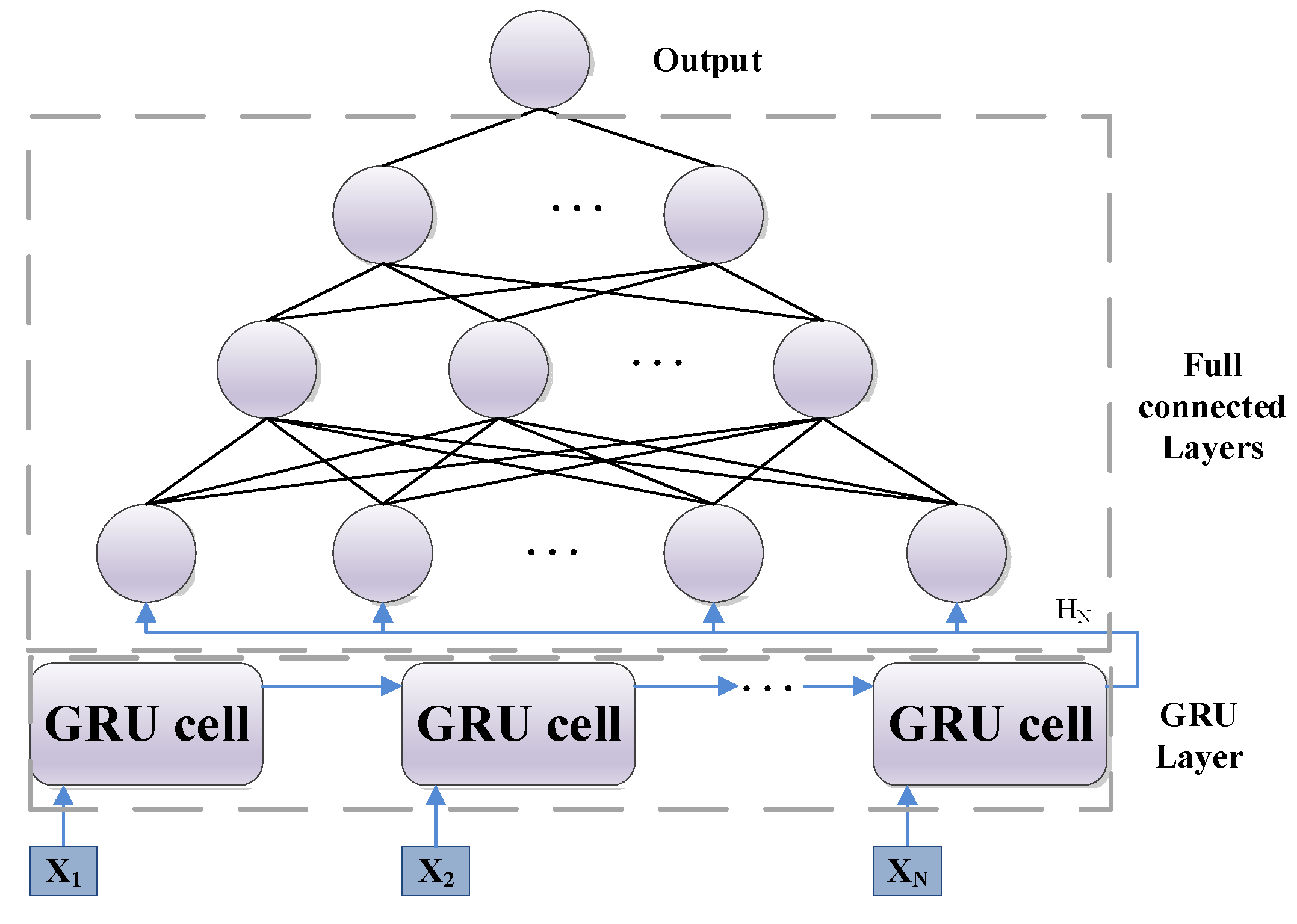
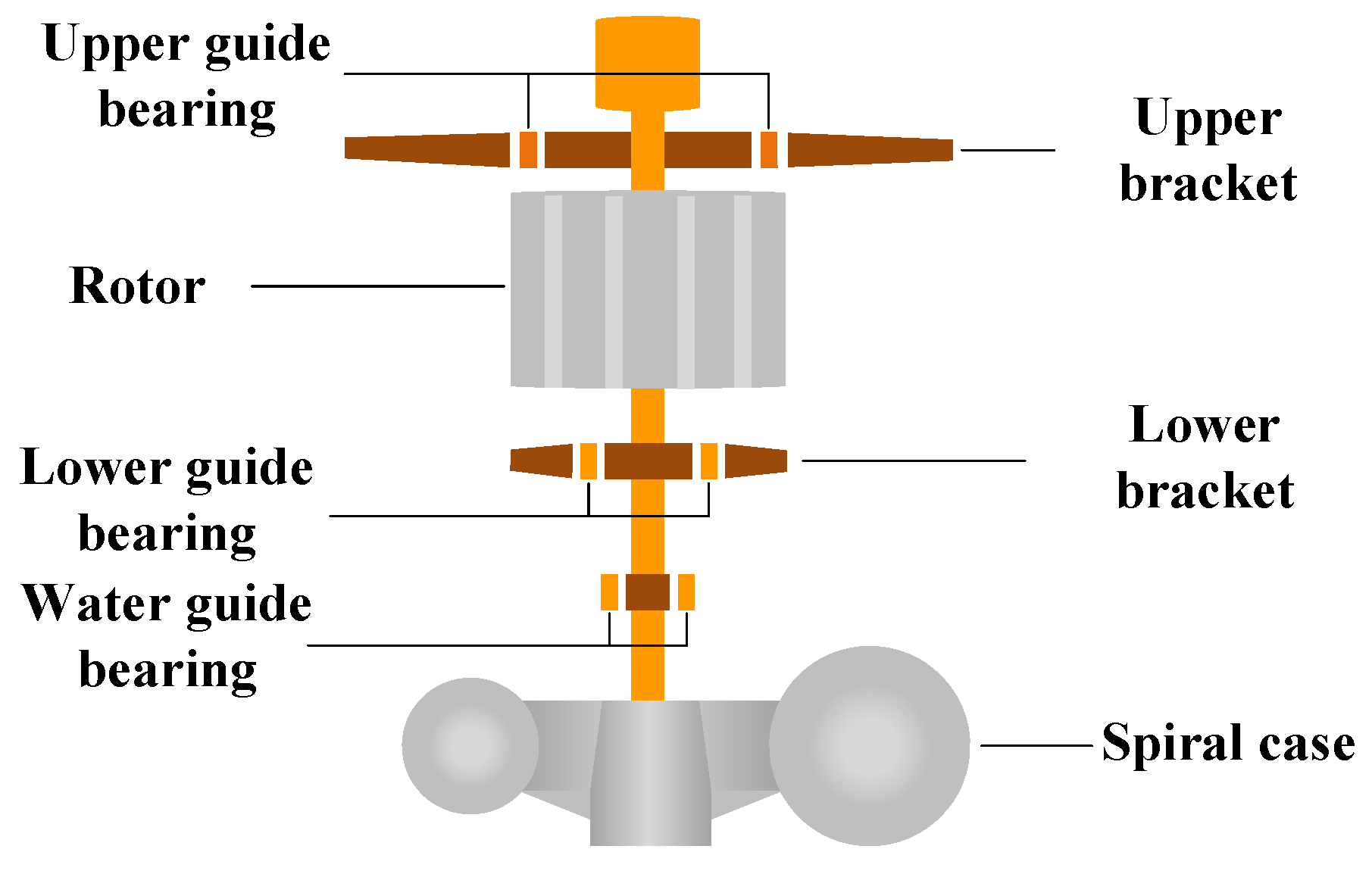
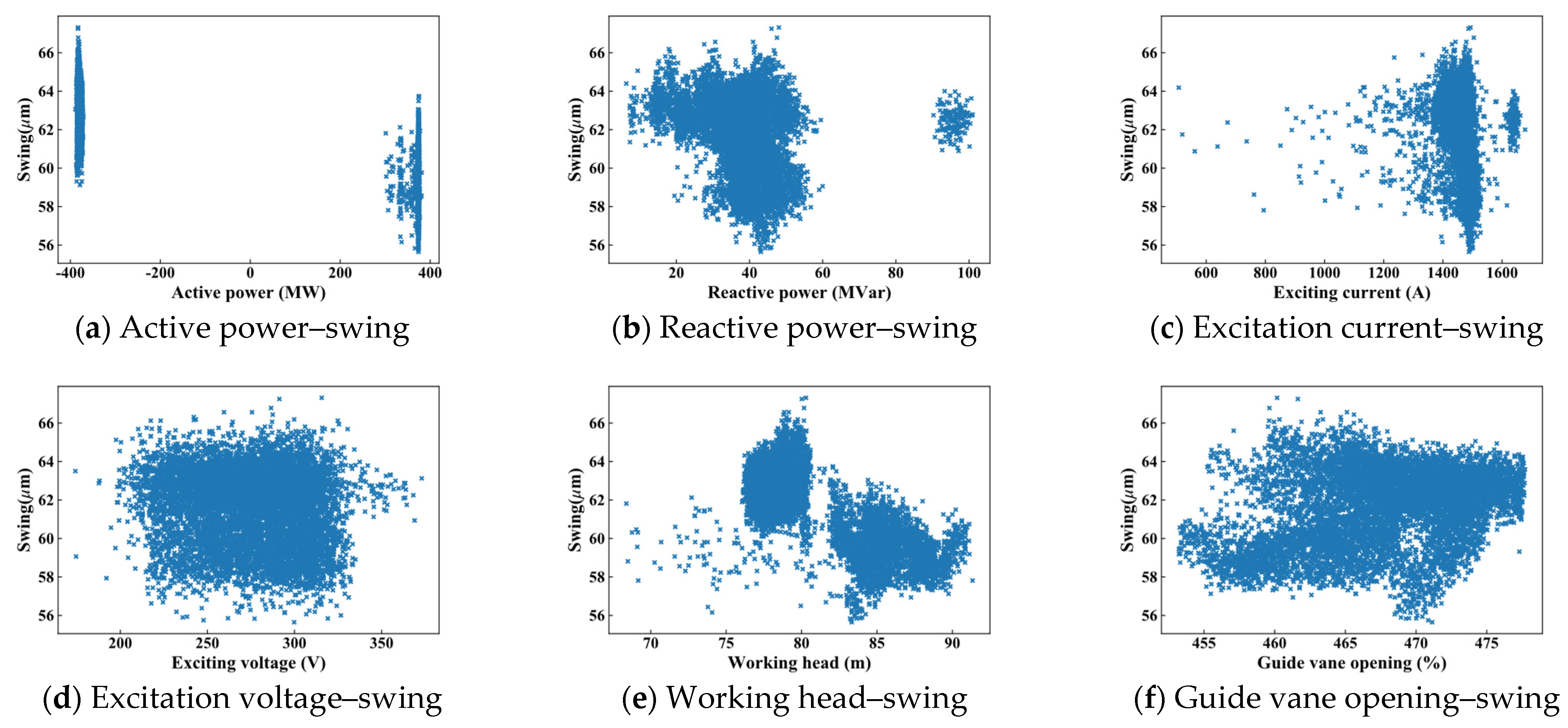

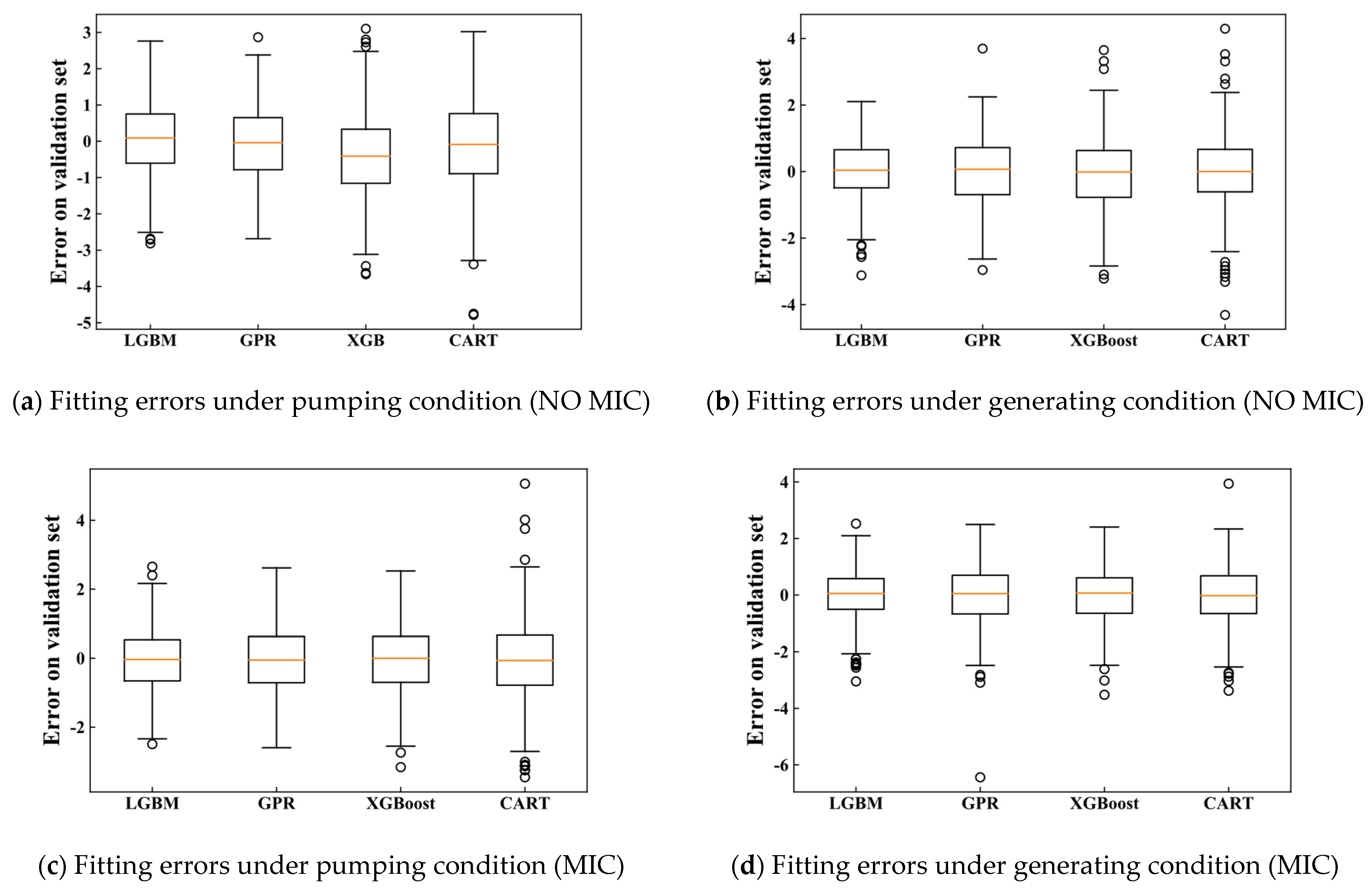
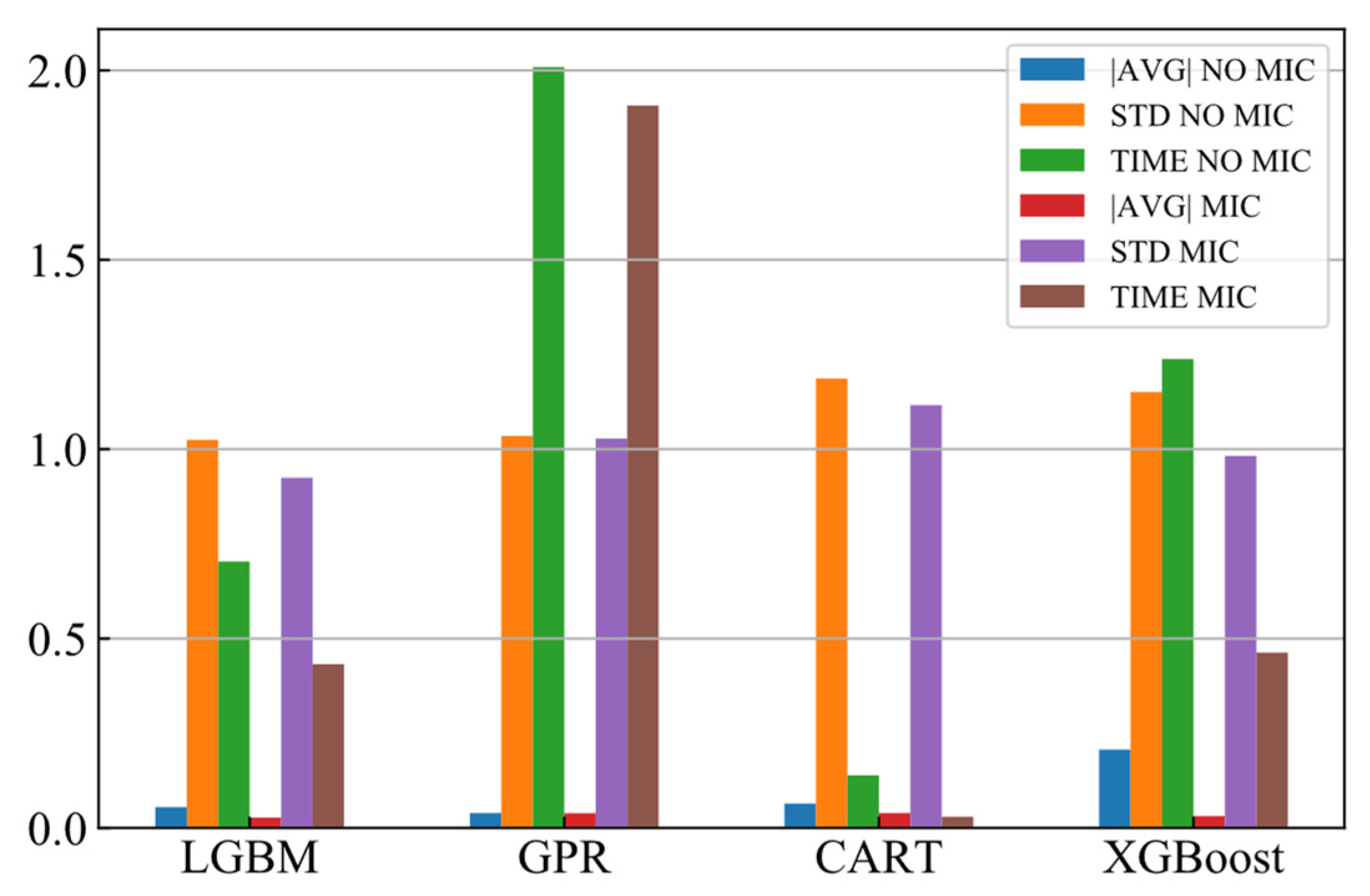
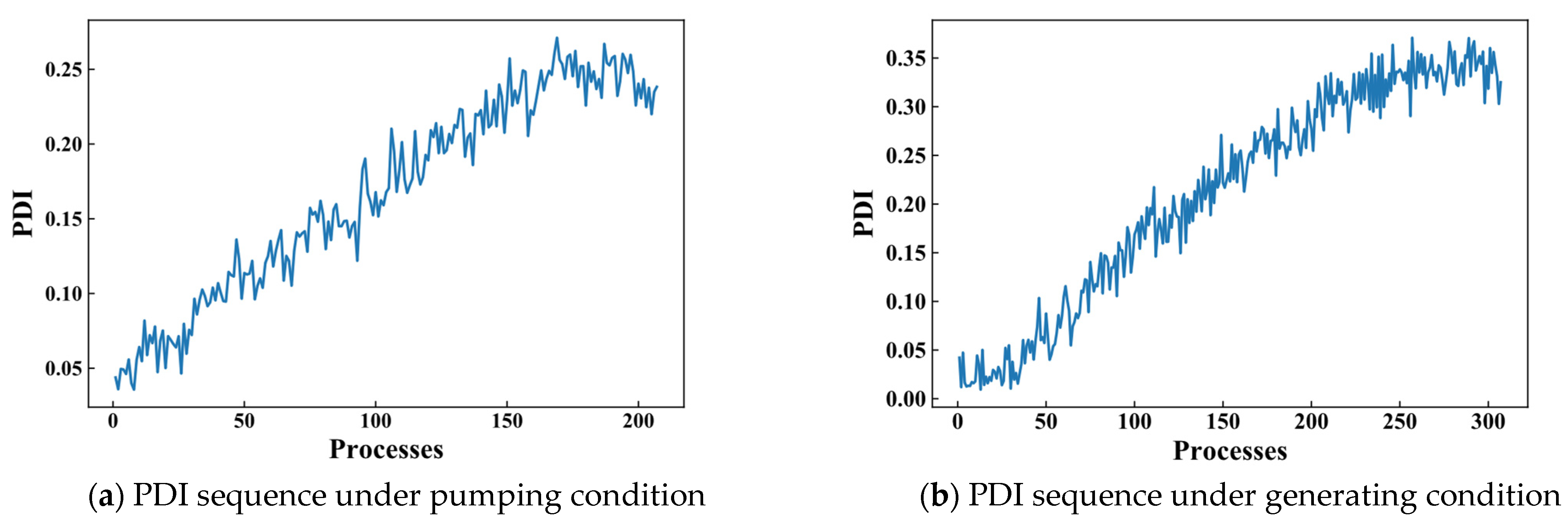
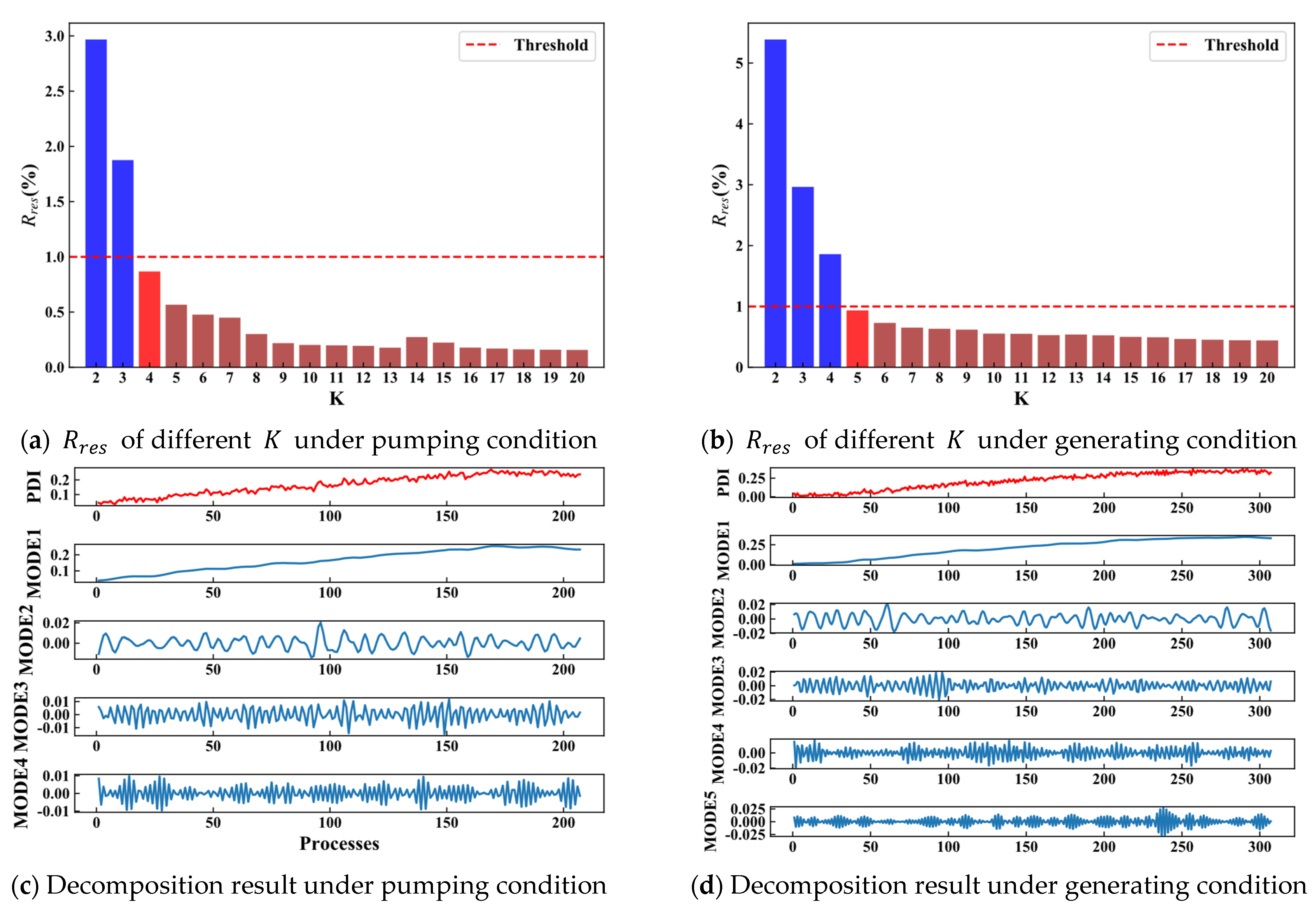
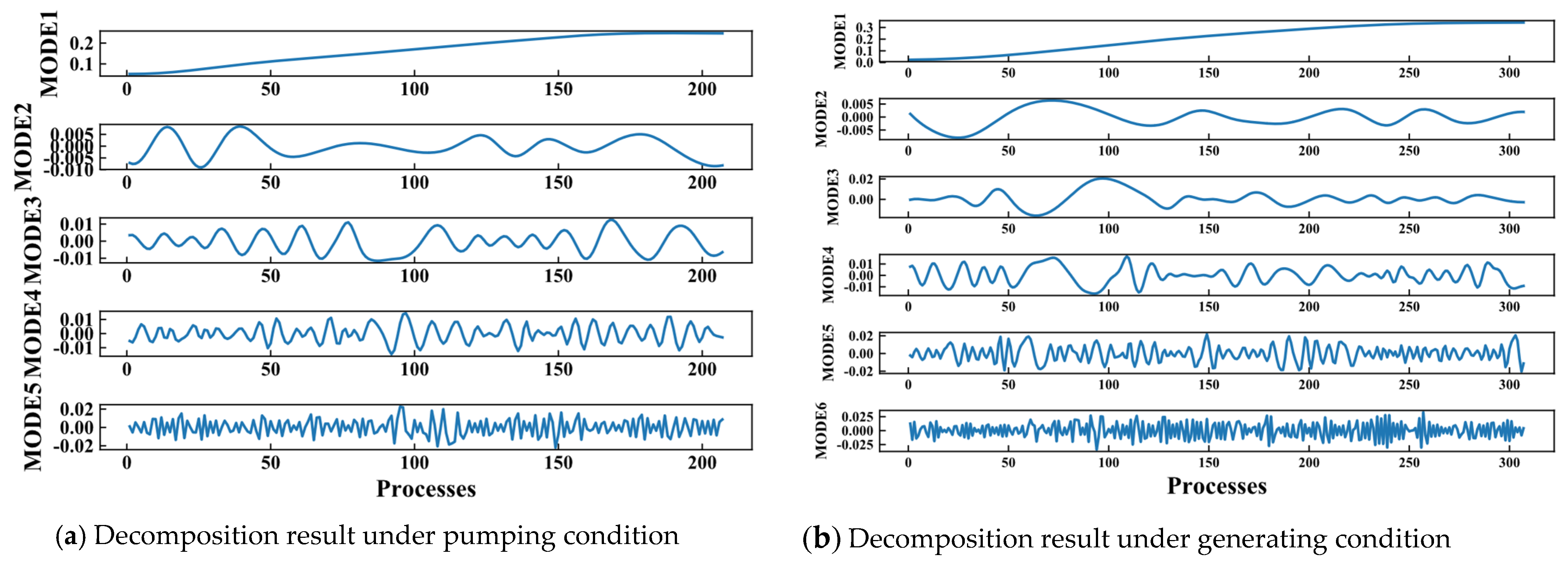
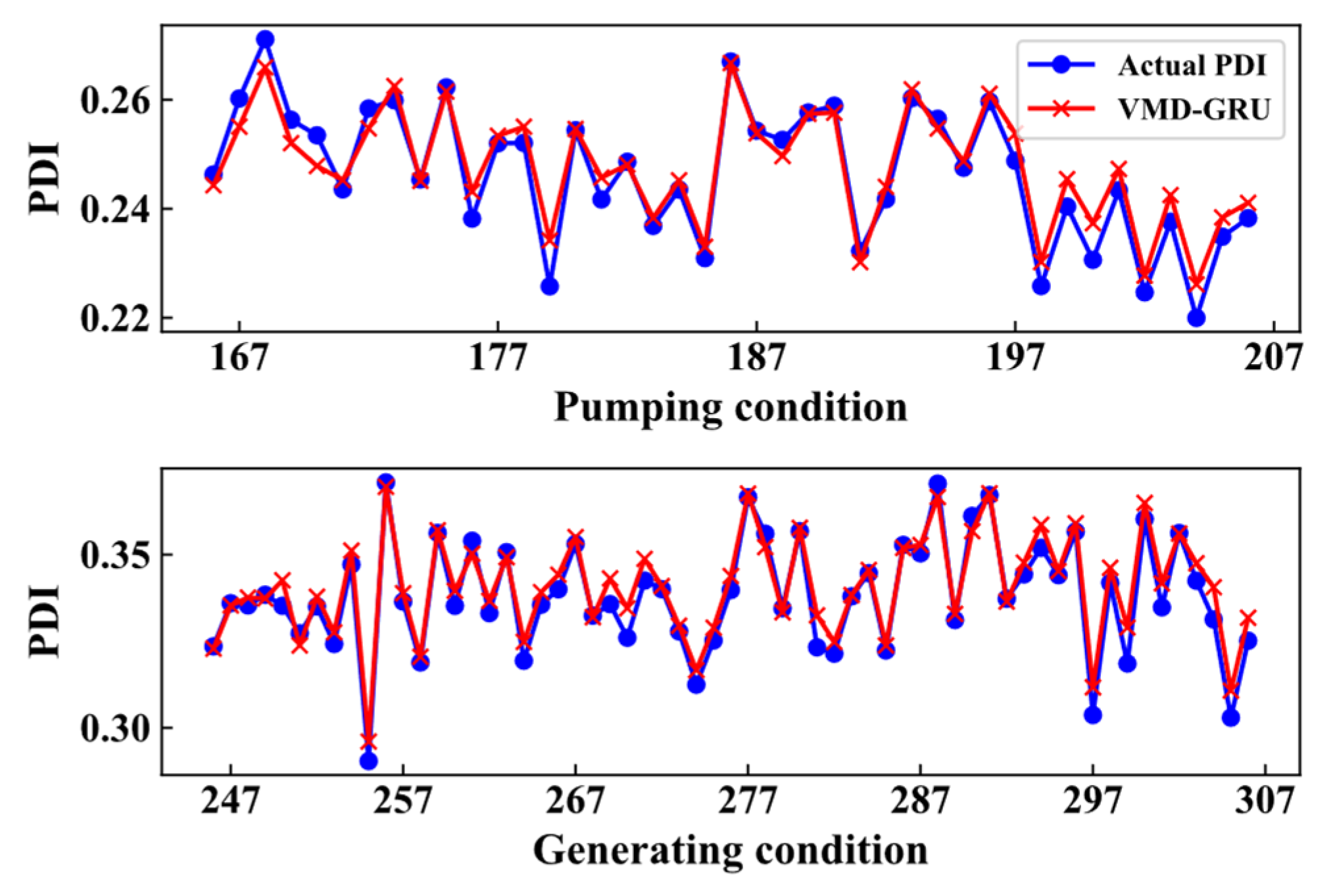
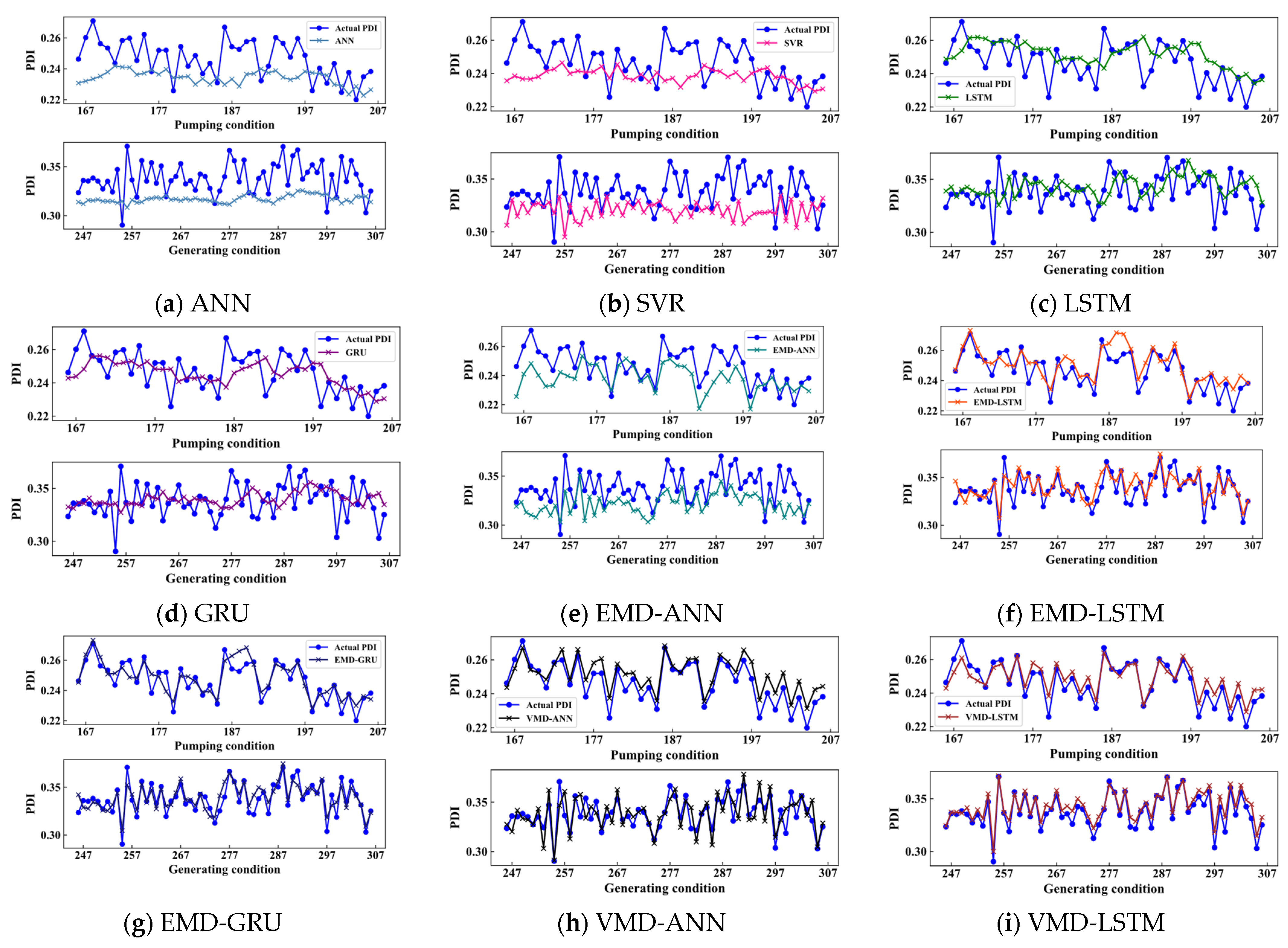
| Model | Parameter Settings |
|---|---|
| GPR | Kernel = ‘RBF’, alpha = ‘1e-9′. |
| CART | Criterion = ‘MSE’, Min_samples_split = 2, Min_samples_leaf = 1. |
| XGBoost | Booster = ‘gbtree’, eta = 0.1, Max_depth = 7, Min_child_weight = 1, Sub_sample = 0.82. |
| LGBM | Max_depth = 8, Num_leaves = 19, Min_child_samples = 30, Sub_sample = 0.85. |
| Parameter Selection | Healthy Model | Pumping Condition | Generating Condition | ||||
|---|---|---|---|---|---|---|---|
| NO MIC | GPR | 0.065 | 1.033 | 2.317 | 0.014 | 1.037 | 1.700 |
| CART | 0.093 | 1.246 | 0.182 | 0.036 | 1.127 | 0.096 | |
| XGBoost | 0.384 | 1.174 | 1.539 | 0.030 | 1.128 | 0.937 | |
| LGBM | 0.082 | 1.055 | 0.755 | 0.028 | 0.994 | 0.652 | |
| MIC | GPR | 0.049 | 0.985 | 2.261 | 0.029 | 1.071 | 1.553 |
| CART | 0.056 | 1.169 | 0.023 | 0.023 | 1.063 | 0.036 | |
| XGBoost | 0.040 | 0.994 | 0.314 | 0.023 | 0.970 | 0.612 | |
| LGBM | 0.036 | 0.911 | 0.302 | 0.019 | 0.938 | 0.563 | |
| Model | Parameter Settings |
|---|---|
| ANN | Four full connected layers, number of neurons: 256, 64, 4, 1. |
| SVR | C = 0.8, Kernel = ‘RBF’, Epsilon = 0.001, Tol = 0.001. |
| LSTM | (a) LSTM Layer, 128 units. (b) Three full connected layers, number of neurons: 256, 64, 1. |
| GRU | (a) GRU Layer, 128 units. (b) Three full connected layers, number of neurons: 256, 32, 1. |
| EMD-ANN | (a) EMD: Decompose until meeting the stopping condition in [51]. (b) ANN sub-model: it has same structure as ANN prediction model. |
| EMD-LSTM | (a) EMD: Decompose until meeting the stopping condition in [51]. (b) LSTM sub-model: The structure is same as LSTM prediction model. |
| EMD-GRU | (a) EMD: Decompose until meeting the stopping condition in [51]. (b) GRU sub-model: The structure is same as GRU prediction model. |
| VMD-ANN | under generating condition. (b) ANN sub-model: it has same structure as ANN prediction model. |
| VMD-LSTM | under generating condition. (b) LSTM sub-model: The structure is same as LSTM prediction model. |
| VMD-GRU | under generating condition. (b) GRU sub-model: The structure is same as GRU prediction model. |
| Prediction Models | Pumping Condition | Generating Condition | ||||
|---|---|---|---|---|---|---|
| ANN | 0.0173 | 0.0149 | −0.9761 | 0.0271 | 0.0232 | −1.7304 |
| SVR | 0.0147 | 0.0125 | −0.4360 | 0.0249 | 0.0208 | −1.3031 |
| LSTM | 0.0129 | 0.0095 | −0.1060 | 0.0190 | 0.0146 | −0.3337 |
| GRU | 0.0118 | 0.0096 | 0.0677 | 0.0178 | 0.0136 | −0.1780 |
| EMD-ANN | 0.0124 | 0.0106 | −0.0187 | 0.0206 | 0.0177 | −0.5713 |
| EMD-LSTM | 0.0076 | 0.0061 | 0.6160 | 0.0099 | 0.0078 | 0.6305 |
| EMD-GRU | 0.0062 | 0.0050 | 0.7457 | 0.0085 | 0.0068 | 0.7328 |
| VMD-ANN | 0.0065 | 0.0056 | 0.7234 | 0.0123 | 0.0100 | 0.4435 |
| VMD-LSTM | 0.0053 | 0.0045 | 0.8131 | 0.0066 | 0.0053 | 0.8405 |
| VMD-GRU | 0.0035 | 0.0029 | 0.9171 | 0.0044 | 0.0035 | 0.9281 |
Publisher’s Note: MDPI stays neutral with regard to jurisdictional claims in published maps and institutional affiliations. |
© 2022 by the authors. Licensee MDPI, Basel, Switzerland. This article is an open access article distributed under the terms and conditions of the Creative Commons Attribution (CC BY) license (https://creativecommons.org/licenses/by/4.0/).
Share and Cite
Chen, P.; Deng, Y.; Zhang, X.; Ma, L.; Yan, Y.; Wu, Y.; Li, C. Degradation Trend Prediction of Pumped Storage Unit Based on MIC-LGBM and VMD-GRU Combined Model. Energies 2022, 15, 605. https://doi.org/10.3390/en15020605
Chen P, Deng Y, Zhang X, Ma L, Yan Y, Wu Y, Li C. Degradation Trend Prediction of Pumped Storage Unit Based on MIC-LGBM and VMD-GRU Combined Model. Energies. 2022; 15(2):605. https://doi.org/10.3390/en15020605
Chicago/Turabian StyleChen, Peng, Yumin Deng, Xuegui Zhang, Li Ma, Yaoliang Yan, Yifan Wu, and Chaoshun Li. 2022. "Degradation Trend Prediction of Pumped Storage Unit Based on MIC-LGBM and VMD-GRU Combined Model" Energies 15, no. 2: 605. https://doi.org/10.3390/en15020605
APA StyleChen, P., Deng, Y., Zhang, X., Ma, L., Yan, Y., Wu, Y., & Li, C. (2022). Degradation Trend Prediction of Pumped Storage Unit Based on MIC-LGBM and VMD-GRU Combined Model. Energies, 15(2), 605. https://doi.org/10.3390/en15020605








